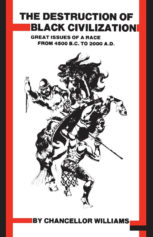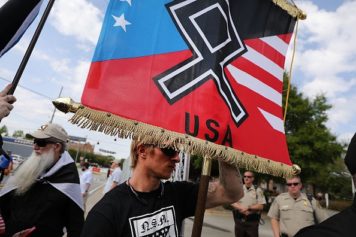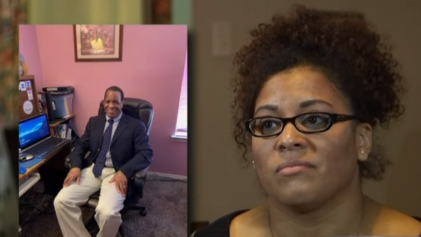
The authors of the study– Dr. Kirkland Hall, former president of the Somerset County chapter of the NAACP, and Prof. Kathryn Barrett-Gaines, director of African-American studies for University of Maryland Eastern Shore—say that Black males are more likely to resort to a life of violence when they feel disenfranchised and believe they are unable to have an impact on society.
The authors told 47 ABC (WMDT) in Salisbury, Maryland their thoughts on what should be done to address the problem.
“We got to get out of that and concentrate on our young kids because when they reach a certain degree of injustice then that means that we have failed, we’re not supporting them and it says to me that a lot of us are just giving up on our young people,” said Hall, who believes older Black men in the community must assume the burden before youth fall prey to negative influences.
Meanwhile, Barrett-Gaines said the education system needs more positive Black male role models.
“We need more black male teachers because they’ll see in that little boy a son and not a future criminal or a future member of the criminal justice system but a future scholar, a scientist, or musician or whatever he can be,” she said.
The data on violence among Black men provides a reason for grave concern. According to the National Center for Victims of Crime, children and youth experience an alarming degree of exposure to violence and crime victimization. Victimization among African-American children is even higher. Compared to their white peers, “Black youth ages 12 to 19 are victims of violent crime at significantly higher rates than their white peers,” according to the center. “Black youth are three times more likely to be victims of reported child abuse or neglect, three times more likely to be victims of robbery, and five times more likely to be victims of homicide. In fact, homicide is the leading cause of death among African American youth ages 15 to 24.”
According to data from the Centers for Disease Control and Prevention, while the leading cause of death among young adults age 20 to 24 is car accidents, for Black men in that age range the leading cause of death is gun violence, as they are four times more likely to die from the former than the former.
The National Center for Victims of Crime also notes that youth exposure to victimization is directly linked to increased negative outcomes such as depression, poor school performance, substance abuse, risky sexual behavior and homelessness. Further, youth victimization “increases the odds of becoming a perpetrator of violent crimes, including felony assault and intimate partner violence, doubles the likelihood of problematic drug use, and increases the odds of committing property crimes.”
In his book, Black On Black Violence, Dr. Amos Wilson wrote that African-Americans are a “Frankenstein creation of the American Dilemma,” with an identity crisis created by Eurocentric projections of an “inflated, confabulated, European image and a complementary deflated, scandalized, apparently and repulsively exposed African image.”
“Consequently,” Wilson concludes, “the victimized African with no positive African identity, and his identification with the false image of the European, can only achieve alienation from reality no matter how normal, law- abiding, abnormal, or criminal he may appear to be.”
He adds that the Black-on-Black violent criminal never completely identifies with the White supremacist aggressors, nor does he completely dis-identify with the victimized African-American community:
The Black-on-Black criminal is a hybrid, a victimized aggressor one motivated and rationalized by his perceived victimization. Like all Africans subject to aggressive European domination he is neither Peter nor Paul. He is caught between the horns of an un-resolvable dilemma. He can never be a White man in the truest sense of the term, and he unalterably refuses to be a Black man in the true sense of the term. Having internalized the Eurocentric definition of what it means to be African all negative as well as having observed the material losses, social ostracism, victimization, rejection, etc., that Europeans and others have applied to those who identify themselves as African, he scurries to the safety of ethnic ambiguity or self- alienation.
Ultimately, Dr. Wilson says, the Black-on-Black violent criminal becomes the Eurocentric stereotype of the Black criminal, as he chooses to identify with the violence and victimizing of white American racist aggression, and tries to reject the Eurocentrically falsified, victimized Black image. Further, Wilson makes the connection between poverty and crime, as white America maintains racism in order to keep Blacks in poverty, which is a crime against Black people in itself.
“Thus, intimating that African American criminality is the result of moral depravity the European/White American community unwittingly incriminates itself and reveals its own criminality,” he writes. “To avoid acknowledgment and confrontation with the fact that the moral attitudes and values are learned by the means just mentioned, and the means are under their control, the White American community must allege that the moral depravity of African Americans is genetic in nature: that it is inherited within their genes. Thus, it absolves itself of all responsibility. It is this type of absolution that sets up a vicious criminal mill wherein the European/White American community produces the criminality it attributes to innate African American venality. This is the most devastating of European/White American self-fulfilling prophecies.”
Wilson also characterizes suicide as “the pre-eminent expression of Black-on-Black violence,” and along with homicide, part of a “collective self-destruction of a race by death.” In his view, the stability of American society depends on a dysfunctional and disorganized Black family, and the acceptance of a racist white value system is causing Black destruction.
As Dr. Jawanza Kunjufu wrote, “A people without their culture will be afraid to walk down the street at three o’clock in the morning and meet someone who looks like them because they can never be sure whether they share the same value system. A people without a culture and values are dangerous.”
Meanwhile, Dr. Asa Hilliard found two themes among young Black people who attempted suicide, including families who had not equipped them to deal with racism, and social isolation resulting from a lack of membership in any organization, club or youth group.
The Pan-African news site House of Knowledge equates “Black-on-Black violence” with suicide, and notes that gangs are like surrogate families, providing our sons with things such as a sense of identity, friendship and loyalty, a sense of family and kinship, and male leadership. Further, nearly all of the needs that gangs satisfy are legitimate, even as the ways in which those needs are met are criminal and anti-social.
House of Knowledge recommends that parents discuss depictions of Black-on-Black violence in the media with their sons, ensure their sons’ needs are positively met, and encourage Black men in the community to establish a rites of passage program for Black boys. Sons are encouraged to use violence only as a last resort, as violence begets violence, don’t associate with those who disrespect Black people, and use self-control, controlling their temper and their mind.


